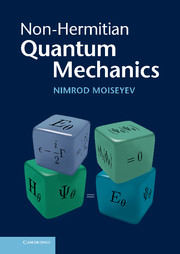Book contents
- Frontmatter
- Contents
- Preface
- 1 Different formulations of quantum mechanics
- 2 Resonance phenomena in nature
- 3 Resonances from Hermitian quantum-mechanical calculations
- 4 Resonances from non-Hermitian quantum mechanical calculations
- 5 Square integrable resonance wavefunctions
- 6 Bi-orthogonal product (c-product)
- 7 The properties of the non-Hermitian Hamiltonian
- 8 Non-Hermitian scattering theory
- 9 The self-orthogonality phenomenon
- 10 The point where QM branches into two formalisms
- Index
5 - Square integrable resonance wavefunctions
Published online by Cambridge University Press: 03 May 2011
- Frontmatter
- Contents
- Preface
- 1 Different formulations of quantum mechanics
- 2 Resonance phenomena in nature
- 3 Resonances from Hermitian quantum-mechanical calculations
- 4 Resonances from non-Hermitian quantum mechanical calculations
- 5 Square integrable resonance wavefunctions
- 6 Bi-orthogonal product (c-product)
- 7 The properties of the non-Hermitian Hamiltonian
- 8 Non-Hermitian scattering theory
- 9 The self-orthogonality phenomenon
- 10 The point where QM branches into two formalisms
- Index
Summary
As discussed in the previous chapter, the poles of the S-matrix are identified with discrete eigenvalues of the time-independent Schrödinger equation, where the asymptotes of the corresponding eigenfunctions are either purely outgoing waves or purely incoming waves. More specifically, the bound and decay resonance poles are obtained by imposing the outgoing boundary conditions on the solutions of the time-independent Schrödinger equation, while the anti-bound and virtual states (sometimes referred to as capture resonances) are associated with the solutions obtained under the requirement of the incoming boundary conditions. Except for the bound states, all other poles of the S-matrix are associated with exponentially divergent wavefunctions which by definition do not belong to the Hilbert space of conventional Hermitian quantum mechanics.
This fact represents a major difficulty for the development of a non-Hermitian quantum mechanical formalism. Consequently, one may wonder, for example, how to properly define an inner product in non-Hermitian quantum mechanics (NHQM) if the wavefunctions diverge asymptotically. We recall in this context that the concept of an inner product constitutes a fundamental building block of standard (Hermitian) quantum mechanics (QM), by means of which one defines the quantum mechanical expectation values of physically observable quantities over the quantum states under consideration. An inner product for NHQM is necessary in order to accommodate the tools of conventional QM. Furthermore, one might anticipate that an appropriate NHQM inner product would also facilitate practical numerical calculation of the S-matrix poles for those cases where the eigenvalues of the Hamiltonian do not possess an analytical closed form expression (unlike the cases studied in the previous chapter).
- Type
- Chapter
- Information
- Non-Hermitian Quantum Mechanics , pp. 116 - 173Publisher: Cambridge University PressPrint publication year: 2011



